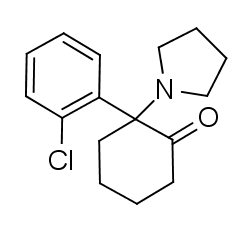-
N&PD Moderators: Skorpio | thegreenhand
-
Neuroscience & Pharmacology Discussion Welcome Guest
Posting Rules Bluelight Rules Recent Journal Articles Chemistry Mega-Thread FREE Chemistry Databases! Self-Education Guide
You are using an out of date browser. It may not display this or other websites correctly.
You should upgrade or use an alternative browser.
You should upgrade or use an alternative browser.
Novel dissociative 2-Chloro-2-Oxo-PCPy
- Thread starter roi
- Start date
Solipsis
Bluelight Crew
- Joined
- Mar 12, 2007
- Messages
- 15,509
Can you suggest in some way how you came up with posting this? Because if it is being sold publically by a popular vendor we can probably expect reports coming in soon or past tense.. and most active substance use is discussed in a focus forum, like PD.
Conversely, if you dug this up in an old article about PCP analogues (somehow I bet it's shelved not nearly *that* far out of reach), we know that we are dealing with SAR projections and that kind of thing...
It would generally help if you would post more than a structural formula.. Id appreciate it, and it would be how things are done on these parts of BL
This being kind of a hybrid between PCPy and ketamine it should be quite sedative / anaesthetic / perhaps narcotic. Which is welcome, I'm not always so up for the dissos that are too stimulating to hole on, or even with manic qualities.
Conversely, if you dug this up in an old article about PCP analogues (somehow I bet it's shelved not nearly *that* far out of reach), we know that we are dealing with SAR projections and that kind of thing...
It would generally help if you would post more than a structural formula.. Id appreciate it, and it would be how things are done on these parts of BL
This being kind of a hybrid between PCPy and ketamine it should be quite sedative / anaesthetic / perhaps narcotic. Which is welcome, I'm not always so up for the dissos that are too stimulating to hole on, or even with manic qualities.
roi
Bluelighter
- Joined
- Sep 2, 2013
- Messages
- 1,545
Can you suggest in some way how you came up with posting this?

It hasn't been mentioned in literature before I think.
Copy pasta on PCPy from Morris' PCP to MXE study:
Substituting PCP’s piperidine ring for pyrrolidine gives PCPy or PHP. In the late 1950s, based on the discovery of PCP, investigators at Parke-Davis synthesized and then investigated PCPy for its anaesthetic potential. Consistent with the animal literature PCPy has a similar potency to PCP in humans and is active via smoking, nasal, and oral routes. In addition to classic dissociative effects, PCPy exerts a sedating effect that has been compared to a barbiturate intoxication by some users. The earliest report of PCPy found was from a sample in Maryland in 1974, and in 1975 the DEA Microgram reported PCPy being sold on leaf material in New Jersey. A high-profile case reported exten- sively by national media outlets is the fatal 1977 shooting of publicly intoxicated biochemist Ronald Burkholder by the Los Angeles Police Department (LAPD). PCPy was subsequently detected in Burkholder’s post-mortem blood serum. During a 1979 congressional hearing on abuse of dangerous drugs, PCPy was mentioned as an example of the growing issue of PCP analogues. This was based on the fact that 14 reported cases of PCPy were detected in 1977, a rise from earlier years. PCPy entered Schedule I of the US CSA on 25 October 1978. Scheduling did not prevent the distribution of PCPy and as early as June 1979 two individuals were convicted for possession of PCPy in Florida. The author of a letter to the New England Journal of Medicine in 1980 speculated on an increase in PCPy availability in LA around this time, which he called a new drug of abuse. The speculation was based on his observation of a sig- nificant rise in PCPy detection in the urine of LA county probationers. Soon after PCPy was detected in a number of hospitalized patients in Ohio with the intoxication said to resemble that of PCP. Most recently, a clandestine chemist in Boston MA was arrested in 1991 for operating a PCPy laboratory. When arrested, he successfully argued that PCPy was not illegal under MA state law but upon continuing his activity was soon arrested by the DEA in June 1993 and convicted for PCPy manufacture under federal law.
This one is much closer to Ketamine though structure wise.
Nexus_Tripper
Bluelighter
- Joined
- Nov 16, 2014
- Messages
- 490
If only that was a 2-bromo or 2-iodo. Then I might actually try this one
Incunabula
Bluelighter
- Joined
- Dec 10, 2010
- Messages
- 1,862
2-Cl-2-Oxo-PCPy - considering how shitty NENK is, I don't see this coming out much better. We'll see.

